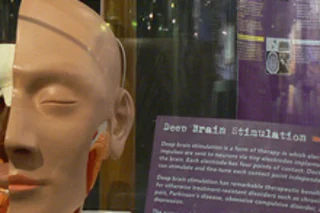Kevin Warwick is about to become telepathic, luck and technology permitting. His lips are parted expectantly as he sits blindfolded and perched on a lab stool at Reading University in England. One inch below his left wrist, a pincushion array of 100 silicon electrodes, all of them together about one-sixteenth the size of a dime, has been surgically inserted into his median nerve. From the electrodes, 22 wires run eight inches under the skin and exit one inch below his elbow. There they are soldered to a connector board where a 2-inch-by-2-inch maze of circuitry amplifies, filters, and converts the electrochemical impulses coming down his median nerve into digital signals. His wife, Irena, sits across the lab, looking considerably more nervous. Three wires exit through needle-hole-size incisions just above her wrist. Irena's setup is less spectacular, jerry-rigged to last only the afternoon, not the three months Warwick has carried his ...
The Bionic Connection
Are we already a lot closer to a mind-machine interface than we ever guessed?
More on Discover
Stay Curious
SubscribeTo The Magazine
Save up to 40% off the cover price when you subscribe to Discover magazine.
Subscribe










